We have a stateless Java Application which I want to be deployed in Azure fabric. I have installed the Fabric SDK and Visual studio tools as per the documentation.
After that I have created the Service Fabric application "Guest Executable" template and my project structure is like below:
I have followed steps similar to the documentation as in https://azure.microsoft.com/en-us/documentation/articles/service-fabric-deploy-existing-app/
My ServiceManifest.xml is below:
<?xml version="1.0" encoding="utf-8"?>
<ServiceManifest Name="Guest1Pkg"
Version="1.0.0"
xmlns="http://schemas.microsoft.com/2011/01/fabric"
xmlns:xsd="http://www.w3.org/2001/XMLSchema"
xmlns:xsi="http://www.w3.org/2001/XMLSchema-instance">
<ServiceTypes>
<StatelessServiceType ServiceTypeName="Guest1Type" UseImplicitHost="true" />
</ServiceTypes>
<CodePackage Name="Code" Version="1.0.0">
<EntryPoint>
<ExeHost>
<Program>HelloWorld.war</Program>
<Arguments></Arguments>
<WorkingFolder>CodePackage</WorkingFolder>
</ExeHost>
</EntryPoint>
</CodePackage>
<ConfigPackage Name="Config" Version="1.0.0" />
<Resources>
<Endpoints>
<Endpoint Name="JavaAppTypeEndpoint" Protocol="http" Port="8080" Type="Input" />
</Endpoints>
</Resources>
</ServiceManifest>
My ApplicationManifest.xml snippet is below:
<?xml version="1.0" encoding="utf-8"?>
<ApplicationManifest ApplicationTypeName="Application1Type"
ApplicationTypeVersion="1.0.0"
xmlns="http://schemas.microsoft.com/2011/01/fabric"
xmlns:xsd="http://www.w3.org/2001/XMLSchema"
xmlns:xsi="http://www.w3.org/2001/XMLSchema-instance">
<Parameters>
<Parameter Name="Guest1_InstanceCount" DefaultValue="-1" />
</Parameters>
<ServiceManifestImport>
<ServiceManifestRef ServiceManifestName="Guest1Pkg" ServiceManifestVersion="1.0.0" />
<ConfigOverrides />
</ServiceManifestImport>
<DefaultServices>
<Service Name="Guest1">
<StatelessService ServiceTypeName="Guest1Type" InstanceCount="[Guest1_InstanceCount]">
<SingletonPartition />
</StatelessService>
</Service>
</DefaultServices>
</ApplicationManifest>
I deployed to Service Fabric Explorer in my local, and the build and publish steps are good without any errors:
-------- Package: Project: Application1 succeeded, Time elapsed: 00:00:00.3530634 --------
2>Started executing script 'Deploy-FabricApplication.ps1'.
2>. 'C:\Users\samanoha\Documents\Visual Studio 2015\Projects\Application1\Application1\Scripts\Deploy-FabricApplication.ps1' -ApplicationPackagePath 'C:\Users\samanoha\Documents\Visual Studio 2015\Projects\Application1\Application1\pkg\Debug' -PublishProfileFile 'C:\Users\samanoha\Documents\Visual Studio 2015\Projects\Application1\Application1\PublishProfiles\Local.5Node.xml' -DeployOnly:$true -UnregisterUnusedApplicationVersionsAfterUpgrade $false -OverrideUpgradeBehavior 'None' -OverwriteBehavior 'Always' -SkipPackageValidation:$true -ErrorAction Stop
2>Copying application to image store...
2>Copy application package succeeded
2>Registering application type...
2>Register application type succeeded
2>Removing application package from image store...
2>Remove application package succeeded
2>Finished executing script 'Deploy-FabricApplication.ps1'.
2>Time elapsed: 00:00:01.9327912
========== Build: 1 succeeded or up-to-date, 0 failed, 0 skipped ==========
========== Deploy: 1 succeeded, 0 failed, 0 skipped ==========
Started executing script 'Publish-NewServiceFabricApplication'.
[void](Connect-ServiceFabricCluster); Import-Module 'C:\Program Files\Microsoft SDKs\Service Fabric\Tools\PSModule\ServiceFabricSDK\ServiceFabricSDK.psm1'; Publish-NewServiceFabricApplication -ApplicationPackagePath 'C:\Users\samanoha\Documents\Visual Studio 2015\Projects\Application1\Application1\pkg\Debug' -ApplicationParameterFilePath 'C:\Users\samanoha\Documents\Visual Studio 2015\Projects\Application1\Application1\PublishProfiles\..\ApplicationParameters\Local.5Node.xml' -ApplicationParameter @{_WFDebugParams_='[]'} -Action Create -SkipPackageValidation:$true -ErrorAction Stop
Creating application...
ApplicationName : fabric:/Application1
ApplicationTypeName : Application1Type
ApplicationTypeVersion : 1.0.0
ApplicationParameters : { "_WFDebugParams_" = "[]" }
Create application succeeded.
Finished executing script 'Publish-NewServiceFabricApplication'.
Time elapsed: 00:00:01.8691591
Started executing script 'Get-ServiceFabricApplicationStatus'.
[void](Connect-ServiceFabricCluster); Import-Module 'C:\Program Files\Microsoft SDKs\Service Fabric\Tools\PSModule\ServiceFabricSDK\ServiceFabricSDK.psm1'; Get-ServiceFabricApplicationStatus -ApplicationName 'fabric:/Application1' -ErrorAction Stop
The application has started.
Service Status:
fabric:/Application1/Guest1 is ready.
The application is ready.
Finished executing script 'Get-ServiceFabricApplicationStatus'.
Time elapsed: 00:00:01.0230548
But the application health state shows error and the event is
"Error event: SourceId='System.Hosting', Property='CodePackageActivation:Code:EntryPoint'.
There was an error during CodePackage activation."
I don't have any idea what might be the issue here in deployment, whether anything needs to be included in Application service Entry point in addition to mentioned above.
Also, The Java webapplication when deployed on Standalone tomcat has the following context http://localhost:8080/HelloWorld/hello . If the Application is deployed in Service fabric cluster, will the URL context for this remains same or should it be something like http://localhost:8080/Application1/Guest1/HelloWorld/hello due to the Azure fabric wrapper around it?

